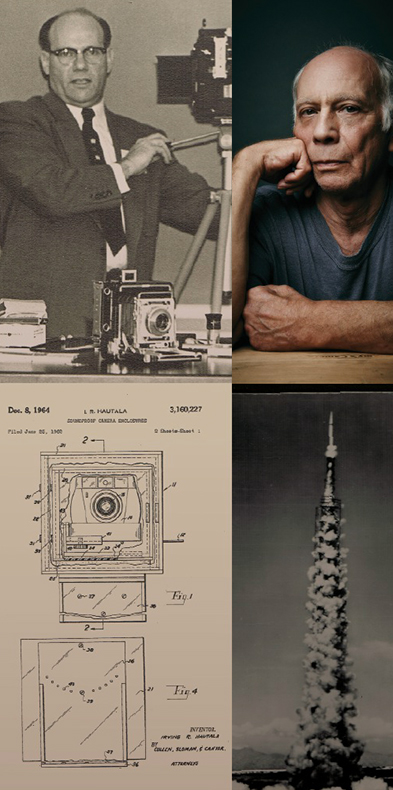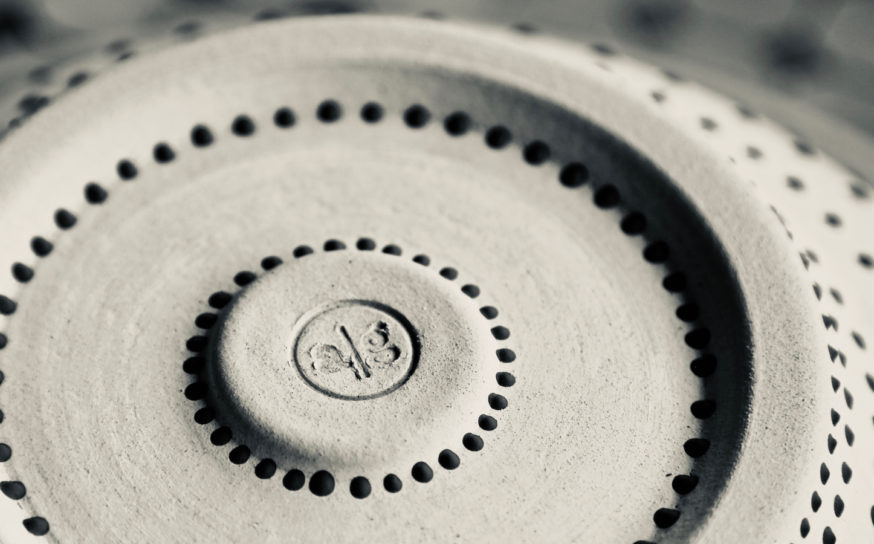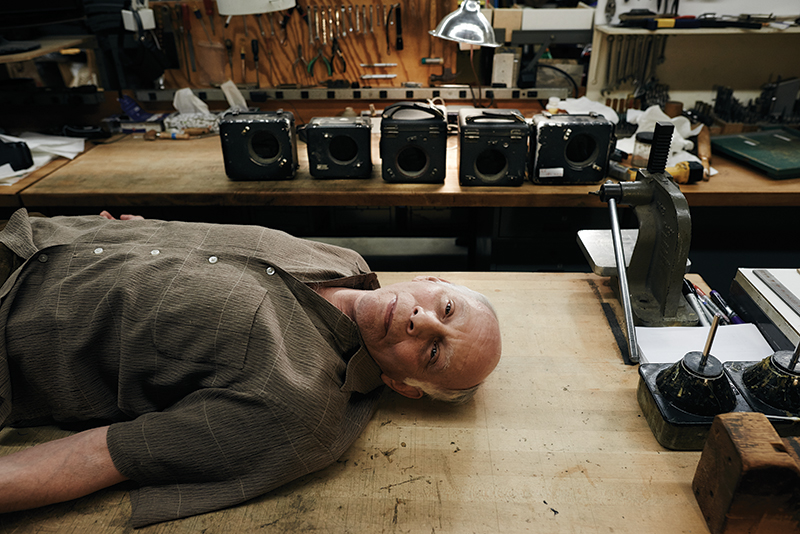
The Silence of the Lens
The story of how Irving Jacobson forever changed the art of photography and how, in a small NoHo studio, his son Mark is keeping his memory and legacy alive.
On a crisp and chilly morning back in 2006, I got a frantic phone call from my husband, Michael, who was working on the CBS Studio Center set of Malcolm in the Middle as the unit photographer. He was busy snapping Cloris Leachman and Bryan Cranston as they exchanged their typically snarky, snappy dialogue.
“I am using a sweater, and it is not working,” he blurted out. “If they notice I don’t have it, I’ll probably get fired. You’ve got to go get it ASAP. Thanks. Love you. Gotta go.”
The it was a piece of professional photography equipment called a sound blimp, a must-have device for a photographer trying to get images on a TV set while actors work nearby. The blimp mutes the jarring, metallic click of a camera’s shutter, which can easily disturb an actor in the middle of a scene.
So I raced down Laurel Canyon to search out to the only man in Los Angeles (or at that time, the world) who would either save the day or potentially end my husband’s career. We’d always heard rumors about Mark Jacobson. Photographers whispered that he had no competition and could make photographers wait for months for this specialized piece of equipment.
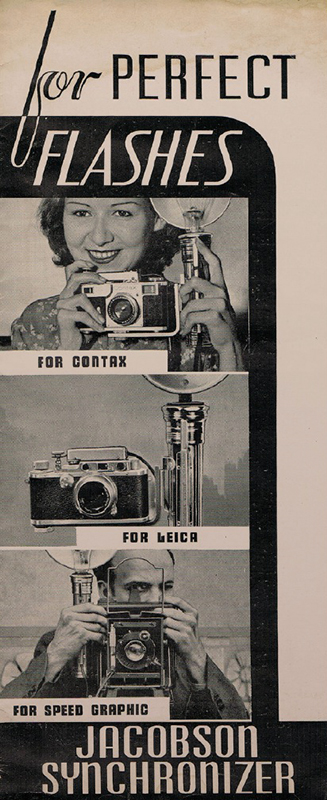 I called Mark from my car. After a long pause on the other end he calmly stated, “I don’t have a new blimp available, but you can come over if you want,” and hung up.
I called Mark from my car. After a long pause on the other end he calmly stated, “I don’t have a new blimp available, but you can come over if you want,” and hung up.
The ratty, grey sweater my husband had wrapped around his Canon DSLR camera on the set of General Hospital the week before had been much appreciated by the crew there, which had described his “rig” as the most creative shutter-silencing they’d seen yet; he figured they were just being kind.
I arrived at Jacobson Photographic Instruments, located on the corner of an industrial street in North Hollywood, and the unglamorous shop took me aback. I felt like I had entered Doc’s garage from Back to the Future.
Rows of small, 8” x 8” matte-black boxes and lens tubes packed with dense, foam soundproofing filled the shelves, surrounded by archaic machines. In front of them stood the man himself, holding one of the small, black boxes. He looked like a professor, dressed in a faded, cotton plaid shirt neatly tucked into his belted slacks.
Breathless (and feeling desperate), I stammered who I was and what I needed. Mark peered over his rimless glasses at me. “Yes, I know what you want. You already told me on the phone. Here is your blimp. I assembled it just for Michael,” he said, clearly savoring the moment as my knees practically buckled in relief. I was so relieved, in fact, that I nearly forgot to hurry over to the set and save my husband’s job.
Behind the Lens
This story would have ended there, but we’d never forgotten Mark’s kindness, and we showed up at his shop earlier this year for a much belated thank-you. We also wanted to find out more about the history of the sound blimp and his father, Irving Jacobson, who’d invented it more than a half-century ago.
We sat down at his old metal desk with a laminate wood top and an original electric typewriter (that Mark still uses), and he explained that his father had been born to Eastern European immigrant parents in 1906, grew up with them in Chicago and always loved tinkering in the garage next to his father’s hardware store. Irving never graduated from college.
Tired of the Chicago winters, a 20-something Irving packed his tools and moved to Los Angeles, where he continued to tinker. A friendship with a newspaper photographer, Frank Filan, became the catalyst that changed Irving’s life in 1937.
The Power of One
Back then, news photographers equipped with a fedora and a press pass tucked in its band were forced to hold a heavy and cumbersome 4” x 5” large-format bellows camera in one hand and a light source in another. Because the light and camera were two separate units, photographers needed to shoot numerous times, hoping the light was perfectly timed with the shutter so at least one shot would be properly lit.
Irving’s photographer pal was fed up with having to over-shoot, and according to Irving’s wife, Sylvia, “kept complaining about it. And Irving finally told him, ‘For heavens sake, stop griping. I’ll fix it.’ And this established Irving’s initial curiosity in photo-mechanical problem-solving.”
Irving created a synchronizing device using a solenoid—a specially designed electromagnet switch that was powered by D batteries. He called this new cylinder-shaped invention a synchronizer. It fit next to the camera body, and the batteries powered the connection to the shutter.
It worked perfectly. When Irving’s pal was assigned to cover a terrible plane accident in the north San Fernando Valley, he showed up, took one quick, perfectly synched shot and left. His colleagues were shocked (and a little peeved) by his speed and confidence—and clamored for Irving’s brilliant invention.
TIME CAPSULE One of Irving's inventions helped photographers
capture the lift-off of a NASA rocket in the '60s. Bottom left: Irving
Jacobson's 1964 drawings of the sound blimp. Upper left:
Irving Jacobson demonstrating the synchronizer.
Irving filed his first patent in 1937 and continued to make synchronizers one at a time in his garage until Graflex, a major camera manufacturer in New York, purchased his patent and offered him a job. They wanted him so badly, that when he said he’d love to work for them but no way was he moving his wife and the two children from the Hollywood Hills back to harsh winters, they opened a West Coast division in LA. Smart move.
Irving had friendships with several famous photographers, including Ansel Adams. As a fun getaway, Irving and his wife would visit Ansel at his home in Yosemite.
As his son tells it, Irving would never charge Ansel for any needed services.
“In the mid-1940s, Ansel wanted to show his appreciation and asked Dad to take one of his prints,” Mark says. “Naturally the picture my mother and dad wanted was the famous Moon Over Hernandez. They always had great taste. Ansel preferred that they pick another. Then his wife proceeded to ask them for $500, stating it was their special ‘friends’ rate. My mom responded, ‘Thank you, but no thank you.’ She never forgave Ansel’s wife, and that was the last time they went to visit.”
The Space Between Us
In 1955 Irving left Graflex and opened his own business on Vine Street in Hollywood. When the race to be first in space was particularly newsworthy, Life magazine photographers were determined to shoot from the side of a cylinder mounted on a test rocket so their readers could see a liftoff from that unique perspective. Irving came to the rescue again.
“You’d have a camera mounted on the inside of the cylinder,” Mark explains. “Then there was an opening on the side, and my dad used prisms to take pictures down the outside. It had to be gravity-activated to turn it on.”
Photography was a regular part of the Jacobson family activities. “When I was a kid my very first camera was a little Leica, but I did not have the talent nor do I still have a talent to be a photographer,” Mark admitted. “My dad was a pretty good photographer but never a professional. My older brother who had the talent, Phillip, did become a successful professional photographer.”
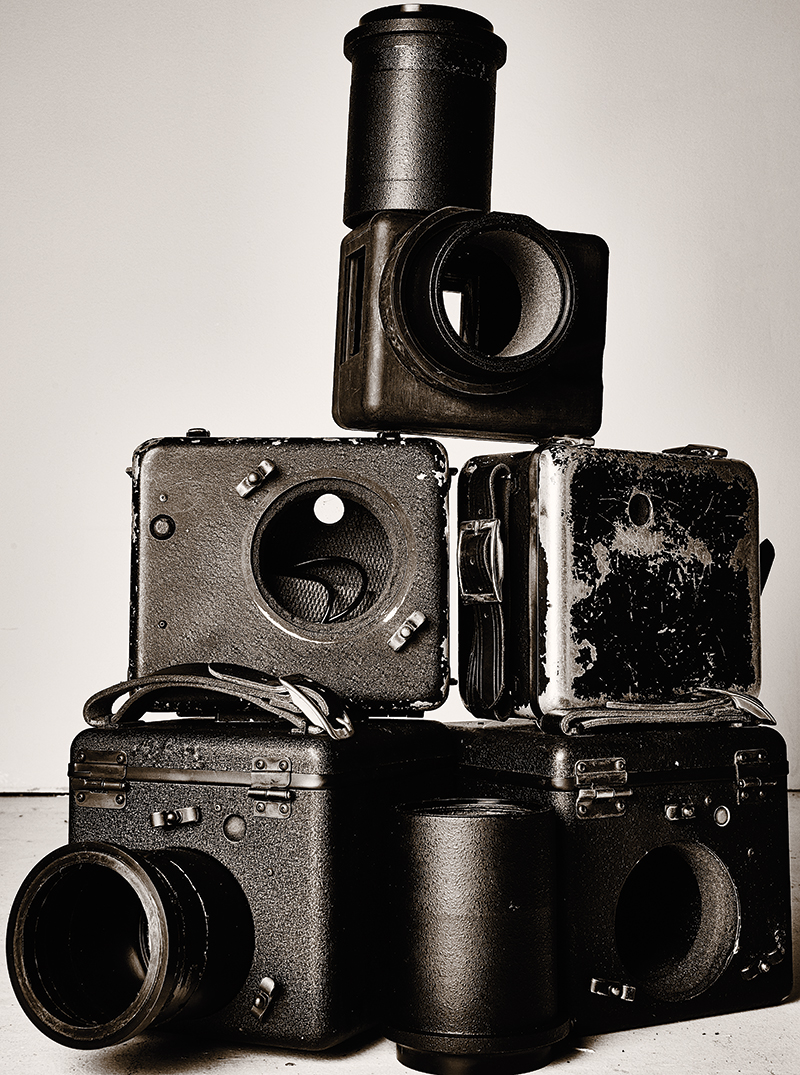
Original Prints
Mark smiles and walks to the safe in his office, where he pulls out a family treasure: an original Nikon F, built “like a tank.” In 1959 the Nikon F became the first successful professional 35mm SLR camera. Pros loved it as it featured a battery-driven motor to advance the film, but the batteries didn’t directly attach to the actual camera.
Photographers had to carry the battery pack on their shoulders or belts with a 3-foot connecting cord. “It was a pain in the butt,” Mark says. “When you moved around, you’d lose contact.”
In 1963 Irving created and patented a motor power supply using common AA batteries. This eliminated the need for a separate pack by attaching the battery pack directly to the motor drive. He called it the PowerCon and made about 1,000 of them at his shop before Nikon started making their own cordless battery packs.
Irving apparently got his best ideas when sleeping—and then upon awaking became obsessed about creating his dreams. By then Mark had started working in his dad’s shop after school. It was around that time that Bill Willoughby, the first freelance photographer hired by the major studios to shoot for Life and Look magazines, came to Irving with a problem.
“In those days a photographer could not shoot during a scene because of the shutter noise,” Mark says. “When the director got the take he wanted with the actors and then wrapped that scene, everybody was exhausted and wanted to go off to their dressing rooms. So when the photographer steps in and says, ‘We have to re-pose this scene so I can shoot it,’ that makes the photographer the most unpopular person on set.”
Bill asked Irving if there was a way to silence the shutter and keep the actors and director contented. Irving was happy to oblige with the device that would seal his place in photography history. Bill only had one condition: “I will pay you for the design and coming up with the solution,” he told Irving, “but do not make another for anyone else for six months.”
Irving agreed, and his ingenious sound blimp was born. And it became extremely popular after the six-month moratorium. In 1962 Irving filed a patent on soundproof camera enclosures he’d invented, and in 1963 another one for a camera control attachment used to trigger the shutter.
“My dad and I not did not necessarily always agree and had battles about the sound blimp, so we made an agreement that Dad continued to invent new designs and I did all the repairs,” Mark admits. “Except for amateur photographer Yul Brynner, who would only let my famous-for-solving-problems father work on his cameras, I did all the repairs. Dad didn’t care that Yul was a famous movie star—only that he was a wonderful photographer. ”
Mark continued working part-time with his dad while pursuing his master’s degree in urban and regional planning. Upon graduating he discovered a scarcity of jobs in that field, so he went to work full-time in Irving’s shop. He has no regrets.
“I don’t know if I could have dealt with the politics. You have to have a certain personality and demeanor,” he says, sounding somewhat cheerful.
In 1967, Popular Mechanics featured a story about John Stephens, a 31-year-old camera operator for MGM’s action film Grand Prix, directed by John Frankenheimer and starring James Garner, and their novel way to photograph the racing cars in action. It was the first time audiences felt as if they were behind the wheel of a Formula 1 powerhouse, roaring along curving streets at speeds up to 140 mph.
This “virtual” feeling (in the days before “virtual” was even part of our vocabulary) was due to Irving’s 1965 invention of a radio-controlled system that remotely operated the camera heads.
Recognition Remiss
Despite his noteworthy contributions both to photography and entertainment, with the exception of more recent photo-buff bloggers, there has never been any mention in actual historical photography timelines of Irving Jacobson, who died in 1994. Not one.
“My dad was a natural inventor and may have been a great engineer, but he was not necessarily the world’s best businessman,” Mark says. “He was never the greedy type of person. Dad was honest, straightforward, very conscientious and almost fanatical as far as being a perfectionist with his work.”
To both my husband and me, as the son spoke about his father, it sounded somewhat poignant. At this moment we realized he could have just as easily been talking about himself.
Architect May Sung Comes to The Rescue on a Studio City Reno Gone Wild
In the right hands…finally!





